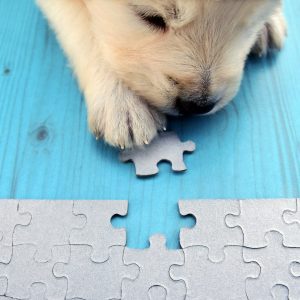When swapping the food bowl and starting dog puzzle feeding the general recommendation is to replace the food bowl and feed the dog using other items. For example:
- food puzzle toys;
- box shredding, milk bottles ……. But is this right for your individual dog?
When designing a fun feeding program it is not a case of ‘one size fits all’. Each individual needs a program designed with their individual skill set and behaviour in mind. A poorly designed feeding program can actually make some behaviours worse.
What type of dog feeding are there?
I break down dog feeding into two categories: Active and passive.
Active:
- dog feeding that excites the dog, increasing the dogs’ emotional arousal.
- any type of puzzle where the dog maintains a high level of excitement whilst solving the problem. Usually using the skills of knocking/hitting, shredding, pulling, pushing, digging, etc.
Passive:
- dog feeding that calms the dog, decreasing the dogs’ emotional arousal.
- any type of puzzle where the dog maintains a lower level of excitement. Usually using the skills of sniffing/foraging and licking.
What type of dog feeding should you use?
The excitable/impulsive dog:
- The aim is to calm.
- Don’t assume that a very excitable dog needs more to do, this can backfire as giving exciting activities to an already excited dog is like adding fuel to a fire!
What to give:
If your dog is already excited then use passive dog feeding. Great starting points include:
- Food scatters building up to food hunts;
- larger ice-blocks and simple Kongs.
Build up to pairing active and passive dog feeding to help teach your dog to excite then calm. For example;
- box shredding with a Kong inside;
- food hunt with some food hidden in more difficult locations to encourage the dog to dig
- move or shred items to access the food, such as under plastic pots, in egg cartons or milk bottles or treat balls.
What to avoid:
Any of the active types of problem-solving, especially those that are too hard or frustrates. As the dog begins to calm, more active types of dog feeding can gradually be introduced. These activities should always be in balance with passive types of dog feeding.
The worried or apprehensive dog
The aim is to build confidence.
What to give:
Enrichment should be passive, high value and very simple to begin with. Start with a very simple food scatter using larger pieces of high-value food that are easy to find. As your dog increases in skill, begin to hide the pieces:
- Offer a very simple Kong using larger high-value pieces of food that the dog can pull out with ease;
- Give a very high-value ice-block made with more food and less water to encourage the dog to work harder.
What to avoid:
Offering too many different types of problem-solving, or feeding that is too hard.
Also, avoid trying to help the dog too much. Allow the dog time to process and problem solve themselves before intervening. If the dog continues to struggle then make the problem easier to solve and increase food value.
The middle of the road dog or puppy
The aim is to mentally stimulate and provide outlets for them to use their ‘skills’.
What to give:
Problem-solving should be a balance of passive and active, as well as use the individual skill set of the dog. For example, if the dog loves to dig, then meet this need by using digging pits, towel lasagnas, etc.
Revise activities to ensure it continues to meet the dog’s individual needs.
What to avoid:
- Giving too much or not enough variety;
- Allowing the dog to become bored.
The above is a guide only. For a designed feeding program for your dog please contact us.
For more dog behaviour help check out some more articles below: